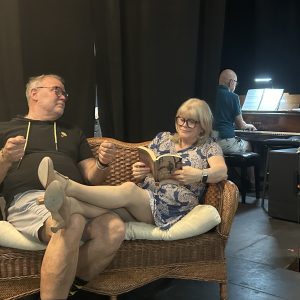 View Winners →
View Winners → 

Father and son artists, Vince Ito (left) and Willie Ito, at their StoryCorps interview (Photo Courtesy of NPR. Captures by Rochelle Hoi-Yiu Kwan/StoryCorps.)
Conventions are not always business as usual. Their size can range from as large as Comic-Con to as minuscule as Mouse-Con, a small-scale Disney convention geared toward Disney collectors and fans alike.
There are some perks to being on the smaller scale. One of the benefits for attendees is the ability to get up close and personal with the panel guests. This year’s Mouse-Con 2019 (November 3, 2019) had old school animators, mouseketeers, and artists from the industry in the line up of panels. One in particular is a local resident of Monterey Park, Willie Ito, more known as the guy who drew the famous “Lady and the Tramp” spaghetti scene.

The Young Japanese American Boy With A Dream
Ito grew up in San Francisco and knew he wanted to be an animator at five years old after watching Snow White and the Seven Dwarves for the first time in a theater. However, at eight years old, Ito and many other Japanese Americans were placed in internment camps. Unexpectedly, it was there that he cultivated and practiced his art.
It was 1954. At 19 years old, Ito started at Chouinard Art Institute, an art school in what is now known as California Institute of the Arts.
“I wasn’t looking for work, I wanted to see the inside of the studio,” Ito explained to his multi-aged audience.
He got his chance to see the animation building while being interviewed for a job he had applied for. The day of the interview he remembered looking at the iconic sign “Dopey Drive” and knew he was ‘there’ and that ‘this’ was it for him.

Meeting Mr. Walt Disney
The moment he least expected was running into Mr. Walt Disney himself.
Fresh from San Francisco, he recalled seeing him on a hot day in Burbank. Ito had been lugging a bulky portfolio filled with pieces from his time in junior high and high school.
The animation building was on the fourth floor. He absorbed the rooms from the entrance to the halls to the elevator as much as he could. It was just as he imagined it as a young boy. And as he entered the elevator, the door began to close, but suddenly it opened. Standing there, was Mr. Walt Disney himself accompanied by a coworker.
“He saw me cowering he gave me a polite nod,” recalled Ito. “I was thinking oh my god!…It was the longest ride ever. We were only going 4 floors!”
After the brief first meeting with Mr. Walt Disney, they parted ways to their respective floors and Ito went on to his interview. The interviewers had enjoyed looking at his portfolio, but gave the well-known “don’t call us we’ll call you” response. Ito wasn’t expecting much from the interview considering his main goal was to see the studio and he had now officially seen it.
However, two weeks later, after night class, he received a Western Union telegram on his door. At the time, this could mean good or bad news:
From Walt Disney Production please report the following Monday to take the following test.
The news was good! They wanted him for the next round before hiring. The following morning he went in at 8 a.m. and took the test. They had him draw six character models from Alice in Wonderland to Cinderella, Mickey, Goofy, and more on a light board in various poses.
After he finished the test and went on to have what he described as a lunch with the production team, they officially decided they liked his work; Ito was hired, at 19-years-old with only three weeks of art school under his belt.
The Lady Unit and Mentorship
Ito started in ‘Lady unit’ as an assistant to Iwao Takamoto, another Japanese American in the business, who had recommended him for the job and the man who would become his best teacher.
As all first jobs usually go, Ito assumed his position was entry level, but later he discovered the ‘Lady unit’ meant “Lady and the Tramp.” He didn’t know they were in production or even heard of it at the time.
Takamoto was there at the desk and started him with the very first drawing from the iconic “Lady and the Tramp” spaghetti scene. In a way, he was thrown into the work, but not without guidance. He was shown the procedure and constantly corrected. Three drawings in, Ito daydreamed about what his father had said, “I should go to barber school so I have something to fall back on [and] I wondered if I’d make a good barber.”
Despite the corrections, Ito had come to learn to persevere. Takamoto worked in this manner to everyone. While Takamoto became Vice President of the studio and was key to designing 75% of characters; he was also Ito’s mentor and good friend.
The Animation Business Was Good to Him
In 1999, Ito retired, but not without a legacy of work that would inspire artists of every age, up to today’s generation. His iconic “Lady and the Tramp” scene was recreated all around the world, and will now even be featured in the live action “Lady and the Tramp” film on Disney+ premiering November 12, 2019.
Ito had started during Disney’s milestone year in 1954 and was present for the opening of Disneyland Park on his birthday the following year 1955.
When Ito wasn’t working with Disney, he also did work for other companies such as Hanna-Barbera, known for Flintsones and Yogi Bear; Sanrio, known for Hello Kitty and more.
Many could take a few pointers from Ito’s story to fathom the possibility that dreams can come true, whether it’s with Disney or anything else we set our hearts on. Because, despite the cliche, an open mind and a little perseverance could have opportunity knocking on our door when we least expect it.














































































































